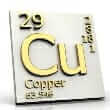Background
- Copper is a mineral that occurs naturally in many foods, including vegetables, legumes, nuts, grains, and fruits, as well as shellfish, avocado, and beef (organs such as liver). Because copper is found in the earth's crust, most of the world's surface water and ground water used for drinking purposes contains small amounts of copper.
- Copper is involved in numerous biochemical reactions in human cells. Copper is a component of multiple enzymes, is involved with the regulation of gene expression, mitochondrial function/cellular metabolism, connective tissue formation, as well as the absorption, storage, and metabolism of iron. Copper levels are tightly regulated in the body.
- Copper toxicity is rare in the general population. Wilson's disease is a genetic disorder in which the body cannot rid itself of copper, resulting in deposition in organs and serious consequences such as liver failure and neurologic damage. Obstruction of bile flow, contamination of dialysis solution (in patients receiving hemodialysis for kidney failure), Indian childhood cirrhosis, and idiopathic copper toxicosis are other rare causes of potentially dangerous excess copper levels. Such individuals should be followed closely by a physician and nutritionist.
- Copper deficiency can occur in infants fed only cow-milk formulas (which are relatively low in copper content), premature/low-birth weight infants, infants with prolonged diarrhea or malnutrition, individuals with malabsorption syndromes (including celiac disease, sprue, or short bowel syndrome), cystic fibrosis, in the elderly, or those receiving intravenous total parenteral nutrition (TPN) or other restrictive diets.
- Medicinal use of copper compounds dates to Hippocrates in 400 B.C. Bacterial growth is inhibited on copper's surface, and hospitals historically installed copper-alloy doorknobs and push-panels as a measure to prevent transmission of infectious disease.
References
- Abdullah AZ, Strafford SM, Brookes SJ, et al. The effect of copper on demineralization of dental enamel. J Dent Res 2006 Nov;85(11):1011-5.
View Abstract - Araya M, Olivares M, Pizarro F, et al. Community-based randomized double-blind study of gastrointestinal effects and copper exposure in drinking water. Environ Health Perspect 2004;112(10):1068-1073.
View Abstract - Behera C, Rautji R, Dogra TD. An unusual suicide with parenteral copper sulphate poisoning: a case report. Med Sci Law 2007 Oct;47(4):357-8.
View Abstract - Bonham M, O'Connor JM, McAnena LB, et al. Zinc supplementation has no effect on lipoprotein metabolism, hemostasis, and putative indices of copper status in healthy men. Biol Trace Elem Res 2003;93(1-3):75-86.
View Abstract - Bremner I. Manifestations of copper excess. Am J Clin Nutr 1998;67(5 Suppl):1069S-1073S.
View Abstract - Donoso A, Cruces P, Camacho J, et al. Acute respiratory distress syndrome resulting from inhalation of powdered copper. Clin Toxicol (Phila) 2007 Sep;45(6):714-6.
View Abstract - el Kholy MS, Gas Allah MA, el Shimi S, et al. Zinc and copper status in children with bronchial asthma and atopic dermatitis. J Egypt Public Health Assoc 1990;65(5-6):657-668.
View Abstract - Ferretti G, Bacchetti T, Menanno F, et al. Effect of genistein against copper-induced lipid peroxidation of human high density lipoproteins (HDL). Atherosclerosis 2004;172(1):55-61.
View Abstract - Gunay N, Yildirim C, Karcioglu O, et al. A series of patients in the emergency department diagnosed with copper poisoning: recognition equals treatment. Tohoku J Exp Med 2006 Jul;209(3):243-8.
View Abstract - Jones AA, DiSilvestro RA, Coleman M, et al. Copper supplementation of adult men: effects on blood copper enzyme activities and indicators of cardiovascular disease risk. Metabolism 1997;46(12):1380-1383.
View Abstract - Kessler H, Bayer TA, Bach D, et al. Intake of copper has no effect on cognition in patients with mild Alzheimer's disease: a pilot phase 2 clinical trial. J Neural Transm 2008;115(8):1181-1187.
View Abstract - Klevay LM. Dietary copper and risk of coronary heart disease. Am J Clin Nutr 2000;71(5):1213-1214.
View Abstract - Mellacheruvu S, Vergara C. A 32-year-old patient with hemolytic anemia and fulminant hepatic failure. Conn Med 2006 May;70(5):293-5.
View Abstract - Oon S, Yap CH, Ihle BU. Acute copper toxicity following copper glycinate injection. Intern Med J 2006 Nov;36(11):741-3.
View Abstract - Patterson RA, Lamb DJ, Leake DS. Mechanisms by which cysteine can inhibit or promote the oxidation of low density lipoprotein by copper. Atherosclerosis 2003;169(1):87-94.
View Abstract







